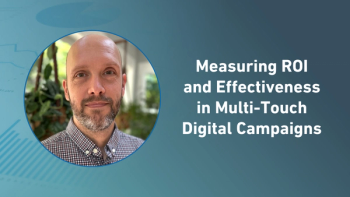
- Applied Clinical Trials-04-01-2025
- Volume 34
- Issue 2
Scaling eSource-Enabled Clinical Trials: Hospital Perspectives
The challenges, opportunities, and strategic outlook for oncology research centers.
Oncology clinical trials are increasingly complex, driven by rising data volumes, regulatory requirements, and inefficiencies in manual data handling. Current trial processes require research staff to manually extract, transcribe, and validate clinical data from electronic health records (EHRs) into electronic data capture (EDC) systems. These manual processes, such as data entry, consume significant time and resources. More than 50% of clinical trial data is duplicated between research systems and hospital EHRs, with around 20% of total study costs typically allocated to data duplication and verification. As oncology trials expand to incorporate genomic, biomarker, imaging, and digital health data, the volume of data per patient is multiplying, intensifying site burden, increasing costs, and slowing trial execution.1,2
eSource technology offers a transformative solution by enabling automated EHR-to-EDC data transfers, eliminating redundant data entry, and improving accuracy. By seamlessly integrating structured data formats such as FHIR, HL7, SNOMED, and LOINC, eSource ensures real-time data availability, reduces errors, and enhances regulatory compliance. Additionally, artificial intelligence (AI)-powered automation is increasingly being leveraged to process unstructured data, such as physician notes, imaging, and pathology reports, further reducing site workload and improving data standardization.3
Early adopters of eSource, such as Memorial Sloan Kettering, Mayo Clinic, and MD Anderson Cancer Center, have reported significant improvements in trial efficiency. Case studies show that eSource can reduce site burden by 50%, cut transcription errors, and accelerate database lock times, ultimately shortening the time to bring new therapies to market.4
As oncology research centers scale eSource adoption, the field is shifting toward a fully digital, clinical trial ecosystem. The transition to real-time, interoperable data capture not only increases efficiency, but also supports adaptive trial designs, enhances patient recruitment, and fosters a collaborative ecosystem among sponsors, technology vendors, and research institutions. eSource represents a pivotal advancement in the future of oncology trials, ensuring they are faster, more cost-effective, and data-driven.
Overview of participating oncology research centers
The six oncology centers that are part of this study represent a broad spectrum of expertise, size, and specialties, playing pivotal roles in global cancer research and care. These centers are also recognized as eSource Champion sites, actively running or preparing for eSource-enabled trials and pioneering innovations in clinical trial efficiency. Mayo Clinic Comprehensive Cancer Center (MCC), spanning three US sites, excels in translational research and conducts more than 1,500 trials annually, supported by 500+ research staff.
City of Hope National Medical Center (COH) in California emphasizes innovative oncology treatments, enrolling 5,000 patients in 730+ annual trials and digitizing workflows for efficiency. MD Anderson Cancer Center (MDA) in Houston, Texas, one of the world’s largest, has 760 inpatient beds and conducts 1,600+ trials yearly. Memorial Sloan Kettering Cancer Center (MSK) in New York, a global leader in cancer care and research, features 514 inpatient beds and currently has more than 1,300 therapeutic clinical trials open, excelling in advanced therapies and precision oncology.
The Cancer Research UK Cambridge Center, including Cambridge University Hospitals (CUH)NHS Foundation Trust, specializes in investigator-initiated trials and translational science within a university hospital, leveraging structured data integration. University Hospital of Essen (UKE) in Germany, with around 1,300 beds, is a leader in digitization, using FHIR-based data systems and AI-driven solutions for unstructured data. Together, these institutions span from 500 to 1,300+ beds and conduct hundreds to thousands of trials annually, underscoring their significant contributions to advancing cancer research and patient care globally. As eSource Champion hospitals, these centers exemplify the potential of digital transformation in oncology research, setting benchmarks for operational excellence and collaboration.5,6
Methodology
This study employed a qualitative research design to explore the adoption, implementation, and scaling of eSource technology across oncology research centers. Semi-structured interviews were conducted with senior representatives, who also served as co-authors, from the six leading institutions: MDA, MCC, COH, CUH, UKE, and MCK. These respondents offered comprehensive insights into the utilization and impact of eSource systems based on their institutional expertise.
The interview guide was structured to capture experiences with current eSource implementations, perceived benefits, technical and operational challenges, strategies for managing unstructured data, and collaborative practices among stakeholders. Each 60-minute interview was audio-recorded, transcribed, and subjected to thematic analysis to identify recurring themes, including interoperability, emerging trends in eSource, broader benefits to stakeholders, and operational efficiency.
To ensure validity, preliminary findings were shared with participants for feedback, facilitating refinements and confirmation of interpretations. The study further assessed the validity and generalizability of the interview outcomes, finding them consistent with the operational practices and strategic priorities of the participating institutions. This iterative and collaborative process reinforced the credibility of the results and ensured alignment with institutional realities.
By synthesizing diverse perspectives, this study illuminates critical success factors for scaling eSource technology in oncology trials and offers actionable insights to improve data integration, streamline workflows, and enhance trial efficiency.
Current use of eSource technology in oncology
The adoption of eSource technology across leading oncology research centers has significantly enhanced data management, trial efficiency, and workflow optimization. By integrating EHR-to-EDC automation, institutions are reducing site burden, improving data accuracy, and enabling real-time access to critical trial data.
Existing implementation and benefits. Several oncology research centers have successfully implemented or are in the process of adopting eSource-enabled trials, demonstrating measurable improvements. At MCC, the deployment of an eSource system has centralized data entry and streamlined workflows, allowing research staff to focus on high-value tasks. Angela Fritsche emphasized, “EHR-to-EDC allows staff to focus on higher-level tasks and improves transparency for patients and sponsors.” Similarly, COH has integrated eSource technology, significantly reducing transcription errors and manual workload. Matthew Bush highlighted, “We reduced transcription errors entirely and decreased data transcription times from 15 minutes to under two minutes per subject.”
Scalability and workflow optimization. eSource technology has proven its ability to scale across multicenter trials. MDA pilot studies demonstrate its feasibility in high-volume research environments, with Lee Andrews stating, “Our coordinators were happy with the time saved from a manual abstraction perspective.” At CUH, eSource has automated lab data transfer, reducing errors and ensuring seamless integration with trial databases. Sarah Burges emphasized, “We want to get rid of the dull, error-prone activity of cutting and pasting. …It’s nonsense in this day and age.”
Impact on data accuracy and compliance. Beyond efficiency gains, eSource improves data integrity and ensures compliance with General Data Protection Regulation (GDPR) and HIPAA regulations. Automated data transfer reduces discrepancies, minimizing protocol deviations, and enhancing audit readiness. With early adopters demonstrating tangible benefits, broader adoption is expected to reshape oncology clinical trials, making them more efficient, scalable, and data driven.
Challenges in scaling eSource technology
EHR interoperability and data quality interoperability remains a key challenge in scaling eSource technology for oncology trials. While FHIR, HL7, SNOMED CT, and LOINC provide structured data frameworks, adoption varies across institutions, requiring extensive mapping and validation. Felix Nensa from UKE noted, “We have close to 500 source systems—mapping these to FHIR repositories requires continuous updates and fine-tuning.” Fritsche from MCC emphasized the need for early data dictionary mapping to ensure reliable extraction. Overcoming these inconsistencies demands collaboration between hospitals, regulatory bodies, and vendors to standardize oncology trial data and enable seamless automation.
Technical and operational challenges. Despite its benefits, eSource implementation faces hurdles in interoperability, data mapping, and legal compliance. Fritsche described the resource-intensive process of mapping the data dictionary but noted, “The transition was smooth with clear expectations.” Andrews from MDA cited legal and data privacy reviews as obstacles, while Nensa from UKE highlighted delays in adapting smart-on-FHIR for non-Epic systems.
Frequent protocol amendments and unstructured data further complicate operations. Bush from COH questioned, “How do we maintain these studies without excessive resource demands?” Addressing these challenges is essential for fully realizing eSource’s potential.
Change management and adoption readiness. Implementing eSource technology requires more than technical upgrades—it demands organizational change management to overcome resistance and streamline adoption. Many research teams are used to manual data entry, making the transition to automation challenging. Burges from CUH noted, “The trust in automation was immediate—after a week, the research staff felt comfortable, but initial skepticism had to be addressed.” Training gaps and compliance protocols also pose barriers, while bureaucracy and legal reviews delay adoption. Andrews from MDA highlighted, “Legal and data privacy concerns have significantly slowed down vendor onboarding.” Targeted training and stakeholder engagement are essential for successful eSource integration.
Beyond three minutes: Unveiling the true time and cost of oncology data management. A retrospective analysis from the EIT Health-sponsored EHR2EDC project (2018–2020) by AstraZeneca and Sanofi found that study personnel spend at least three minutes per data point in Phase II-III oncology trials.7 This includes searching, manual entry, review, and query resolution. For a study with 10 patients contributing 10,000 data points each, the cumulative workload reaches 5,000 hours. In Phase III trials with 200+ patients, the time and costs increase exponentially, highlighting the urgent need for automation and eSource adoption.
Insights from MSK 2024 eSource use case suggest that the three-minute estimate for data entry is conservative for standard data points.2 Complex entries, such as adverse events or abnormal lab values, can take five to 10 minutes per entry. Input from five additional oncology centers corroborates these findings, with respondents reporting that straightforward data points require five minutes, while complex entries demand even more time.
Bush from COH noted, “The variability of data complexity makes a significant difference—what used to take three minutes can now take upwards of 10, depending on the query’s depth.”
Nensa from UKE emphasized the challenge, stating, “Every additional layer of complexity in the data expands the time needed to ensure accuracy and compliance.”
These revised estimates carry major cost implications. In a trial with 10,000 data points per patient, increasing the average entry time from three to five minutes raises the total workload by 33%—equating to $30,000 to $50,000 in transcription costs per patient and 8,300 hours of additional effort for 10 patients. However, eSource adoption results in $15,000 in cost savings per patient, alleviating resource burdens (see Figure 1).
Scaling across Phase III trials, manual entry requires thousands of additional hours, significantly inflating costs. eSource technology offers a transformative solution by automating data capture and integrating AI-driven workflows. MCC has reported a 50% reduction in data entry times with eSource implementation. Fritsche emphasized, “Automation is critical—not just for speed but for accuracy and scalability.” These advancements enhance efficiency, improve data integrity, and accelerate clinical research, ensuring that oncology trials are faster, more cost-effective, and scalable.
Unstructured data management. Unstructured data, including clinical notes, imaging, and pathology reports, remains a major challenge in eSource implementation. Nensa from UKE highlighted AI’s potential, stating, “AI-driven solutions are already capable of transforming text into standardized formats.” However, variability in physician notetaking and imaging structures complicates automation. To address this, strategies include creating structured fields within EHRs to reduce reliance on free text. Burgess noted, “The challenge with unstructured data is that every site documents things differently. Standardizing EHR fields for key oncology data points would eliminate much of the manual effort needed for data abstraction.”
Opportunities with eSource
The adoption of eSource technology presents transformative opportunities for oncology clinical trials, enhancing efficiency, data quality, and collaboration. By automating data capture, reducing manual site burden, and enabling AI-driven structured data integration, eSource accelerates research while improving accuracy and compliance. Additionally, eSource facilitates the improved design of electronic case report forms, ensuring that data collection aligns seamlessly with study protocols, enhances standardization, and reduces the need for post-hoc data reconciliation.
Reducing site burden through automation. A significant advantage of eSource is its ability to automate data capture and eliminate redundant manual transcription. Traditionally, clinical research coordinators spend substantial time manually extracting and transcribing patient data from EHRs to EDC systems. By integrating FHIR, HL7, and standardized application programming interfaces, eSource automates this process, reducing transcription errors and allowing research staff to focus on higher-value tasks. Fritsche from MCC emphasized, “EHR-to-EDC automation enables staff to focus on patient care instead of being bogged down by data entry.” This shift improves workflow efficiency and reduces site workload.
Enhancing data quality through AI integration. AI-driven eSource solutions significantly improve data accuracy, completeness, and regulatory compliance. AI-powered natural language processing (NLP) and machine learning enable structured data extraction, ensuring consistency across multi-site trials. MSK has reported a 99% reduction in data entry errors after implementing eSource.4 Bush from COH highlighted, “AI-driven automation has the potential to improve data integrity, reducing discrepancies that arise from human input.” Improved data quality not only accelerates trial timelines but also enhances regulatory submissions and real-world evidence generation.
Collaborative ecosystem development for standardization. Scaling eSource requires multi-site, multi-vendor collaborations to drive interoperability and industry-wide standardization. Stakeholder alignment among hospitals, sponsors, regulatory agencies, and technology vendors is critical for ensuring widespread adoption.
Burges from CUH stressed, “Collaboration is the tipping point—sponsors must mandate eSource to drive industry-wide adoption.” Establishing pre-competitive frameworks and cross-industry alliances will facilitate seamless data sharing and reduce implementation barriers. By reducing burden, improving data quality, and fostering collaboration, eSource unlocks new possibilities for oncology research, enabling faster, more cost-effective, and patient-centered clinical trials.
The role of AI in eSource implementation
As the complexity of oncology trials grows, AI is emerging as a key enabler in eSource implementation, streamlining data extraction, improving trial efficiency, and enhancing decision-making. By automating manual processes, structuring unstructured data, and supporting predictive analytics, AI transforms how clinical trials manage and utilize real-world data.8
AI for automation and data extraction. AI-powered NLP and machine learning reduce the manual workload required for data abstraction. Traditionally, research staff spend hours transcribing EHR data into EDC systems, but AI-driven automation extracts, maps, and validates structured and unstructured data in real time. Nensa from UKE noted, “We no longer need human intervention for routine data abstraction—AI algorithms can accurately extract and map patient data directly to the trial database.” This accelerates trial timelines and allows research teams to focus on more complex tasks.
AI in trial design, patient stratification, and safety monitoring. Beyond automating data transfer, AI optimizes trial design, patient recruitment, and risk management. AI-driven algorithms analyze large datasets to identify ideal patient cohorts, improving trial enrollment. AI also enhances adverse event detection, monitoring clinical data in real time to flag safety risks before they escalate. Fritsche from MCC stated, “AI-driven risk detection models allow us to intervene earlier in patient care, reducing the likelihood of severe adverse events.”
Addressing unstructured data with AI. Unstructured data—such as physician notes, imaging scans, and pathology reports—poses a significant challenge in oncology trials. AI-powered tools convert these complex datasets into structured, analyzable formats. At MSK, AI processes radiology and pathology reports, extracting key biomarkers. Andrews from MDA highlighted, “By leveraging AI, we can integrate imaging and genomic data directly into trial workflows, reducing manual effort in data extraction.”
Navigating regulatory uncertainty in AI in clinical trials. Despite its transformative potential, the adoption of AI in clinical research faces challenges, particularly around regulatory acceptance and compliance. While regulatory agencies have signaled support for AI’s ability to improve trial efficiency, they have not defined clear, standardized pathways for validating its use. This uncertainty leaves clinical trial sponsors cautious, balancing the promise of faster, more accurate data collection with the risk of regulatory pushback during submissions. As the regulatory framework evolves, collaborative efforts between research sites, sponsors, technology providers, and the regulators will be crucial in implementing AI-driven clinical trial workflows.
Outlook and emerging technologies
The next two to five years will be transformative for eSource technology in oncology clinical trials, driving efficiency, scalability, and real-time insights. Experts anticipate a fundamental shift toward automated data integration, real-time analytics, and AI-powered decision-making, establishing eSource as the standard method for clinical trial data management.
The future of eSource in clinical trials. Respondents widely foresee a future where eSource is fully embedded into trial workflows, reducing manual data entry and enabling more efficient study execution. Burges from CUH remarked, “We’ll see eSource becoming the backbone of all trials, reducing manual input and enabling faster, more accurate insights.”
This transition is expected to bring near real-time data flow, minimizing delays between data collection and analysis. AI-driven automation will also play a critical role in eliminating inefficiencies in unstructured data processing. Fritsche from MCC noted, “In three years, we’ll laugh at discussing structured data. The future is unstructured data and AI learning disease-specific languages.” This signals a major shift from structured, rule-based data extraction toward AI-driven, adaptive learning models that can interpret physician notes, imaging, and genomics.
AI and machine learning as key enablers. Emerging technologies such as AI and machine learning are set to revolutionize patient recruitment, trial matching, and risk monitoring. Bush from COH emphasized AI’s role in clinical decision-making, stating, “AI could transform adverse-event signaling and structured tumor measurements.” AI’s ability to process large datasets in real time will enhance adverse event detection, predictive modeling, and trial optimization. Nensa from UKE underscored the potential of AI-driven text-to-FHIR models such as the “Pigeon” system, which converts unstructured text into standardized FHIR-formatted data. This innovation could significantly improve data interoperability and accessibility across oncology research centers.9
The transformational shift: Fully eSource-enabled trials. The transition to fully eSource-enabled studies marks a pivotal moment in clinical research, where all participating sites leverage automated data capture, real-time integration, and AI-driven validation. This shift eliminates manual data transcription, enhances interoperability, and enables real-time trial monitoring, significantly reducing the administrative burden on research sites. Within the next two years, Phase I oncology trials are expected to be fully eSource-enabled, leading to a six-month reduction in database lock times. The impact on cost efficiency, trial speed, and data accuracy will be profound, helping to bring new therapies to market faster.
As illustrated in Figure 2 below, this transformation replaces traditional clinical trial execution—characterized by manual data entry, fragmented systems, and inefficiencies—with a streamlined, AI-powered ecosystem. eSource reduces site burden, improves data integrity, and enhances regulatory compliance, creating a scalable, interoperable framework for clinical research.
By integrating real-time data capture, AI-driven validation, and standardized data structures, eSource ensures trials are conducted more efficiently, cost-effectively, and with greater precision. This evolution not only optimizes trial workflows and compliance but also positions oncology research centers at the forefront of digital transformation in clinical trials.
Key strategies for eSource implementation
Scaling eSource technology requires a multi-faceted approach that balances operational readiness, stakeholder engagement, and regulatory alignment. A common theme among respondents was the need for collaboration between sponsors, healthcare organizations, and technology vendors to drive adoption and standardization.
Key success factors for implementation. Early adopters highlight strategic planning, resource allocation, and interoperability as essential for successful eSource implementation. Andrews from MDA emphasized, “It’s incumbent upon major players to push the industry to standardize around eSource technology.” MCC’s approach included proactive data mapping and system integration, with Fritsche noting, “The upfront work of mapping the data dictionary was a lift, but the transition was smooth with clear expectations.”
To scale eSource effectively, organizations must prioritize structured data formats, compliance frameworks, and cross-site collaboration. Burges from CUH stressed, “Sponsors need to mandate eSource use to create a tipping point for broader adoption.”
Best practices for stakeholders.Successful eSource adoption requires alignment among research sites, sponsors, and technology providers. Bush from COH emphasized, “Collaboration across sites is key to creating scalable, replicable processes.” Early integration planning ensures EHR-to-EDC interoperability from the start, while regulatory alignment with HIPAA, GDPR, and FDA 21 CFR Part 11 is critical for compliance. Additionally, training and change management help research staff adopt eSource technology effectively, reducing resistance and maximizing efficiency in clinical trial workflows.
Ensuring interoperability and data flow. Interoperability remains a key challenge in scaling eSource, requiring standardized data structures and seamless system integration. Oncology research centers face EHR variability and vendor restrictions, complicating automation. Nensa from UKE noted, “Once the data is standardized and structured, we’ve completed 80% of the journey.” Adopting FHIR, HL7, SNOMED, and LOINC ensures real-time data exchange, improves consistency, and enhances trial efficiency and compliance.
Early adopter case studies/collaboration. Institutions leading eSource adoption emphasize the value of real-world case studies to demonstrate feasibility and impact. eSource has streamlined workflows, reduced manual entry, and improved trial efficiency, allowing research staff to focus on patient care. Andrews from MDA expressed this industry shift succinctly: “Thank God, I can finally focus on talking to patients rather than being a data monkey.”
Pre-competitive collaboration is also essential. Burges advocated for “multi-vendor, multi-sponsor collaborations” to tackle interoperability challenges. Andrews reinforced this sentiment: “The pendulum swings back to balance when collaboration drives alignment across the ecosystem.”
Conclusion
The adoption of eSource technology is transforming clinical trials, enhancing efficiency, data quality, and scalability. Oncology has led this shift, but other therapeutic areas, including neurology, cardiology, and rare diseases, are also embracing eSource to streamline research and reduce manual burdens. A key driver of this expansion is the i-HD eSource Scale-Up Task Force,10 which plays an impartial role in accelerating adoption across sites, sponsors, and vendors. By fostering collaboration and standardization, it helps ensure seamless integration and scalability across the clinical trial ecosystem.
As eSource becomes the standard for clinical data management, it will enable real-time data flow, adaptive trial designs, and improved patient engagement. Continued collaboration among stakeholders will be critical.
Mats Sundgren, PhD, The European Institute for Innovation through Health Data, i-HD; Sarah Burge, Cambridge University Hospitals NHS Foundation Trust; Lee Andrews II, MD Anderson Cancer Center; Matthew Bush, City of Hope; Angela Fritsche, Mayo Clinic; Felix Nensa, University Hospital of Essen; Joe Lengfellner, Memorial Sloan Kettering Cancer Center (MSK)
References
1. Kalankesh, L.R.; Monaghesh, E. Utilization of EHRs for Clinical Trials: A Systematic Review. BMC Med. Res. Methodol. 2024. 24 (70).
2. Sundgren, M.; Santiago, G.; Lengfellner, J. Streamlining Clinical Trials with eSource: Insights from MSK. Applied Clinical Trials. 2024. 36 (8), 22-26.
3. Hume, S.; Abolafia, J.; Low, G. Use of HL7 FHIR as eSource to Pre-populate CDASH Case Report Forms Using a CDISC ODM API. CDISC.
4. Lengfellner, J.; Yeatman, R. EHR-to-EDC at Memorial Sloan Kettering Cancer Center (MSK). Podium presentation. March 3, 2025. Association for Clinical Data Management, Prague, Czech Republic.
5. Participating research centers in study:
6. Oncology News Central.
7. Ammour, N.; Griffon, N.; Djadi-Prat, J.; et al. TransFAIR Study: A European Multicenter Experimental Comparison of EHR2EDC Technology to the Usual Manual Method for eCRF Data Collection. BMJ HCI. 2023. 30 (1).
8. Xiaoran, L.; Yang, C.; Liang, L.; et al. Artificial Intelligence for Optimizing Recruitment and Retention in Clinical Trials: A Scoping Review. JAMIA. 2024. 31 (11), 2749–2759.
9. Miller, T.M.; McMurry A.J.; Jones, J.; et al. The SMART Text2FHIR Pipeline. medRxiv. March 21, 2023.
10. eSource for Scaling Up Clinical Trials Program. i-HD.
Articles in this issue
8 months ago
What’s Next for DEI?8 months ago
Benchmarking Risks Across Therapeutic AreasNewsletter
Stay current in clinical research with Applied Clinical Trials, providing expert insights, regulatory updates, and practical strategies for successful clinical trial design and execution.






.png)



.png)



.png)
.png)
